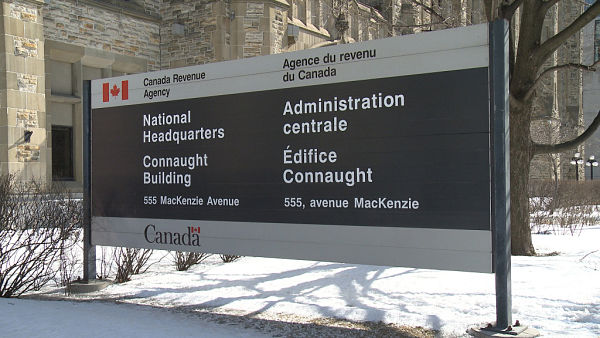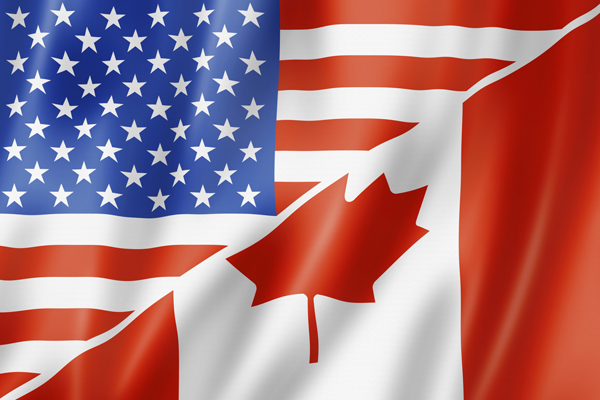The Canadian government has shared more than 1.6 million Canadian banking records with the U.S. Internal Revenue Service since the start of a controversial information-sharing agreement in 2014, CBC News has learned.
In 2016 and again in 2017, the Canada Revenue Agency provided the IRS with information on 600,000 Canadian bank accounts each year. That’s a sharp increase from the 300,000 records shared in 2015 and the 150,000 records shared in 2014, the year the sharing began.
However, that doesn’t necessarily correspond to the number of people affected. Some people may have more than one bank account, while some joint accounts could have more than one account holder — including people who don’t hold U.S. citizenship.
Among the items of Canadian bank account information being shared with the U.S. are the names and addresses of account holders, account numbers, account balances or values, and information about certain payments such as interest, dividends, other income and proceeds of disposition.
The information transfer is the result of a controversial information sharing agreement between Canada and the U.S. negotiated in the wake of the American government’s adoption of the Foreign Account Tax Compliance Act (FATCA). The act, adopted in a bid to curb offshore tax evasion, obliges foreign financial institutions to report information about accounts held by people who could be subject to U.S. taxes.
The Canadian government argued that negotiating the information-sharing agreement would be better than forcing Canadian banks to deal directly with the IRS. Under the agreement, Canadian financial institutions send information on accounts held by clients with U.S. indicia (such as the account-holder being born in the United States) to the CRA; once a year, the CRA then forwards the information to the IRS.
In return, the IRS is supposed to send the CRA information about U.S. bank accounts held by Canadians. The CRA, however, has repeatedly refused to reveal how many records, if any, it has received from the IRS as a result of the agreement.
Nor does the CRA automatically notify Canadian account holders when their information is transferred to the U.S., said CRA spokesman Etienne Biram.
“There is no legislative requirement to disclose this information,” he wrote. “However, if requested by a taxpayer, the CRA will confirm whether information relating to a particular individual or entity has been reported and provided to the United States of America under FATCA.”
The CRA said the increase in the number of records transferred from one year to the next was expected because certain financial accounts did not have to be reported during the first two years of the agreement.
The revelation that 1.6 million records have been shared with the U.S comes as the Federal Court of Canada prepares to hear a constitutional challenge of the information-sharing agreement next week in Vancouver.
Those challenging the agreement argue that it violates sections 7, 8 and 15 of Canada’s Charter of Rights, which protect Canadians from violations of their right to life, liberty and security, unreasonable search and seizure and discrimination against those who hold U.S. as well as Canadian citizenship.
In its submission to the court, the plaintiffs argue that some of the people whose banking records have been shared with the IRS may not be subject to U.S. taxes.
The government, however, presents the information-sharing agreement as the lesser of available evils and an attempt to mitigate the potential impact of FATCA, which included a potential 30 per cent withholding tax on institutions that didn’t comply.
“There were potentially severe consequences to the Canadian financial sector, its customers and investors, and to the Canadian economy as a whole if Canadian financial institutions were unable or unwilling to comply with FATCA,” wrote the government in its submission to the court.
“Canada sought to avoid those consequences and at the same time obtain less burdensome compliance rules for Canadian financial institutions and their customers, and additional information from the United States for Canadian tax compliance purposes.”
The government argues the deal doesn’t violate any charter rights — and that even if it does, it is a reasonable limit on those rights given what was at stake. It also points out that close to 100 countries have negotiated similar deals with the U.S. in the wake of FATCA.
Stephen Kish is a member of the Alliance for the Defence of Canadian Sovereignty, which mounted the legal challenge. He questioned how many of those records should have been shared.
“It’s a huge number of accounts. What our lawyers are trying to find out is how many of those accounts were those of Canadian citizens, how many of those accounts were, in fact, U.S. persons, how many of those accounts should not have been sent because they didn’t achieve the correct account balance.”
Conservative Revenue Critic Pat Kelly said sharing banking records with the IRS has increased the number of Canadian residents at risk of being hit by the repatriation tax signed into law by U.S. President Donald Trump in December 2017. The tax has hit thousands of Canadian residents with U.S. or dual citizenship and a company incorporated in Canada.
“The information sharing agreement … helps facilitate giving the IRS a target list in Canada,” he said. “The Canadian government has to respect Canadians’ privacy and be aware of all of these consequences.”
NDP Revenue Critic Pierre-Luc Dusseault said the CRA should proactively notify Canadian bank account holders when information about their accounts is transferred to the U.S.
“The CRA should do its job of informing their citizens, the taxpayers of Canada that they are taking their personal banking information and transferring it to a foreign country. This is the bare minimum and it shows again the lack of transparency of this government.”
Written by Elizabeth Thompson elizabeth.thompson@cbc.ca
Canada’s latest budget proposes increasing tax authority resources, toughening beneficial ownership reporting requirements for trusts, and further amending rules to limit the advantages of holding passive savings in a corporation.
In its 2018 budget plan, announced February 27, the Canadian Department of Finance focused on measures to ensure a “fair tax system for all Canadians,” noting the Canada Revenue Agency’s recent efforts to target noncompliance in the highest-risk areas, including wealthy Canadians holding offshore accounts.
To that end, the CRA had examined 187,000 large money transfers worth more than C $177 billion between Canada and eight countries, and is now carrying out more than 1,000 offshore audits and more than 40 criminal cases related to offshore transactions, according to the budget plan.
As a result, the government will set aside C $90.6 million over five years for the CRA to handle the extra caseload, and provide C $41.9 million over five years to the Courts Administration Service to help support the Tax Court of Canada.
“We can’t have an economy that works for everyone, if everyone doesn’t pay their fair share,” Finance Minister Bill Morneau said in his budget speech. “That’s why we’ve given the Canada Revenue Agency $1 billion in our first budgets to crack down on tax cheats and offshore tax havens. And with every dollar we invest, we expect $5 in recovered revenue.”
To further help the CRA and other authorities tackle aggressive tax avoidance, tax evasion, and money laundering through abuse of corporate vehicles, the government wants to introduce enhanced income tax reporting requirements for some types of trusts, requiring additional information to be provided annually for 2021 and later tax years. Specifically, the additional requirements would apply to Canada-resident “express trusts” and to nonresident trusts that are currently required to file T3 returns.
The government also seeks changes to the Canada Business Corporations Act to enhance the availability of beneficial ownership information, according to the budget plan.
To crack down on taxpayers who try to sidestep their Canadian income tax obligations by shifting property income into foreign resident corporations, the budget provides measures limiting the use of “tracking arrangements” that allow these taxpayers to track the specific benefit they receive from assets they contribute to a foreign resident corporation.
The budget also provides C $38.7 million over five years to the CRA to help it properly use in its offshore compliance activities the financial account data it obtains through automatic information exchange.
Moreover, the Department of Finance introduced two measures to limit the advantages that some businesses enjoy from holding passive savings in a Canadian-controlled private corporation (CCPC). The first measure would gradually reduce access to the small business rate for CCPCs with large amounts of passive savings. The government proposed lowering the tax rate for qualifying active business income of small CCPCs from 10.5 percent to 10 percent in 2018, then to 9 percent in 2019, to help free up after-tax income for small businesses owners to reinvest in their active businesses. The lower rate is less than the general corporate rate of 15 percent and applies to up to C $500,000 of a CCPC’s qualifying active business, also known as the “business limit.” The first measure would reduce the business limit on a straight-line basis for CCPCs that have between C $50,000 and C $150,000 in investment income, according to the budget plan.
The second measure would curb the tax advantages that bigger CCPCs enjoy. Large CCPCs would no longer qualify for refunds on taxes paid on investment income while distributing dividends arising from income that is taxed at the general corporate rate, according to the budget plan. The two proposals would apply to tax years after 2018.
“We are changing the rules for 3 percent of private corporations, because the wealthiest Canadians should not be able to use private corporations to pay less tax than the middle class,” Morneau said during his speech.
The Department of Finance first announced it would address tax planning via CCPCs in its March 2017 budget. It launched a consultation in July on proposed legislative changes to crack down on three tax planning strategies involving CCPCs.
After extensive cross-country consultations, Morneau announced additional changes to help assuage concerns from middle-income small business owners who use CCPCs for legitimate business purposes, including a C $50,000 per year threshold on passive income.
In December the Department of Finance announced further amendments to its proposals, in particular those related to “income sprinkling,” a strategy that involves funneling income from a wealthy individual using a CCPC to other family members who may not have any role in the corporation and who are subject to lower personal tax rates or are not taxed at all. The changes included bright-line tests to limit the potential effect of anti-income-sprinkling rules on those who make legitimate contributions to affected businesses. The revisions took effect January 1.
By Stephanie Soong Johnston
I was surfing the internet and came across an article that said I had to report my US real estate to the Canada Revenue Agency (“CRA”). This can’t be right, so I called my tax advisor and she told me that was in fact true in certain circumstances. She went on to tell me that the penalty for not informing the CRA of my US real estate could cost me up to $2,500 per year! I have owned that property for 8 years. That’s a cost of $20,000! What am I going to do?!
The above situation is extremely common. Canadians buying foreign real estate as an investment and renting it out are subject to foreign reporting obligations. Failure to report certain property to the CRA may result in a failure to file penalty of up to $2,500 per year. The issues are further complicated if the rental property is held by a US LLC. The penalty shoots up to $12,500 per year. It could be costly to get caught up. Fortunately, the CRA has a Voluntary Disclosure Program (“VDP”), to encourage individuals and businesses to come forward and resolve issues of noncompliance under current regulations that span one or more tax years. Coming forward under the VDP, is a chance to get caught up on past delinquencies and avoid paying large penalty and interest charges.
The application process requires full disclosure of information relating to income tax which is at least one year past due, or generalized and harmonized sales tax (GST/HST) that is one reporting period late. The program also allows taxpayers to completely disclose information regarding other taxes such as excise tax, duties (under the Excise Act, 2001), and source deductions. In exchange for coming forward, the taxpayer may have interest and penalties either waived or adjusted, as well as avoiding any criminal prosecution for tax avoidance.
But wait….
When March 1, 2018 arrives, there will be new rules for those interested in the Canadian VDP for non-compliant taxpayers to consider. There will be two VDP tracks: General and Limited.
Under the General Program, taxpayers will not be charged penalties and will not be referred for criminal prosecution related to the information being disclosed. The CRA will provide partial interest relief for years preceding the three most recent years of returns required to be filed. The determination for which VDP track you will qualify will be on a case-by-case basis. Some of the factors used by the CRA in making the decision include: dollar amount involved, number of years of non-compliance and the tax knowledge/sophistication of the taxpayer.
Changes to the General Program include the requirement of all unpaid taxes to be paid as a condition of qualifying for the program. This means that the payment of unpaid tax must be made before you are admitted into the VDP.
Another change affects the “no-names” disclosures previously allowed. The process of making a disclosure on a no-names basis has been eliminated. A new “pre-disclosure discussion” maybe had by the taxpayer or the taxpayer’s representative with a CRA official, anonymously, however this discussion does not guarantee acceptance into either of the VDP tracks.
The new Limited Program, which will launch on March 1st, will not be as generous as the General Program. Interest and penalties will not be waived or adjusted, however, criminal prosecution can still be avoided. Applications by large corporations (i.e. having revenues in excess of $250 million in at least 2 of the last 5 taxation years, including related parties), will generally be considered under the Limited Program. As with the General Program, any unpaid taxes must be paid before admittance to the VDP.
As has been the CRA’s position in the past, it will not accept taxpayers into either VDP track if they are already known to the agency or if a VDP submission was previously made.
If you have past due returns or forms with the CRA, please contact us as soon as possible before the rules change on March 1st.
With increased collaboration between friendly nations, CRA is working to deter and identify those who participate in off-shore tax evasion. Independent agreements to assist each other are coupled with a membership in the Joint International Taskforce on Shared Intelligence and Collaboration (JITSIC). The information exchange has supplied data on off-shore accounts for years now but due to the exposure of the Panama Papers, there has been an increased focus on tax evasion by most nations, thus the teamwork has intensified.
CRA currently has 990 audits and 42 criminal investigations underway. The federal government is acutely aware of this multi-billion dollar issue and is investing a billion dollars itself to tackle it. They have studied the complexity of this global problem and will continue to allocate resources to recoup the lost funds, working closely with provinces and territories as well. The additional funding is allowing the CRA to move forward with coordinated efforts to ensure that all of those who benefit from Canada’s great lifestyle pay their fair share for it.
CRA’s promise to vigorously pursue those breaking the law and hold them accountable extends from the participants to those that assist them. One proof of this is the $44 million assessed in 3rd party penalties in 2016 against tax advisors. Another example would be the long list of criminal tax evasion cases in the federal court queues. The agency is closely monitoring money transfers over $10,000 heading to specific off-shore destinations regardless of their Canadian source. They are also evaluating 100% of large MNC’s for tax avoidance risk, analyzing high net worth taxpayers they deem risky for tax affairs and using paid informants to gather information.
Much of this work is done through the JITSIC and its 37 participating nations, each gathering and sharing data and information. They have a common commitment to find effective and efficient ways of handling tax evasion or avoidance. Since the Panama Papers went public, the member nations have shared different tools they use to detect criminal acts and trained each other to understand the results of data gathered. They have established structures and mechanisms to better analyze the data and successfully impede high risk targets’ illegal acts. In addition, they have secured ways of sharing sensitive information that adhere to legal frameworks and they have increased the speed with which this information passes between member nations. These enhancements have aided their coordinated responses to locate criminal activities and secure moneys that would otherwise be lost to them.
If you hold any non-Canadian financial assets with an aggregated tax cost of over $100,000 which you never disclosed on your Canadian tax return, please contact us immediately. We will advise and assist you with tax compliance options to minimize penalties.
Post #6 – How Can HCBT Help
In the previous posts, we outlined:
- tax compliance and reporting issues that S1 & S2 had not dealt with;
- how HCBT could help correct prior year problems / reduce penalty exposure through a VDP submission;
- assist with CofC submissions and the reporting of the property sale;
What we cannot do is eliminate the incremental stress and professional costs of dealing with tax authorities in a time crunch before a pending sale.
What can be learned from this?
There are important triggering life events when every taxpayer should seek appropriate and timely professional advice. In the cross border context, all moves between countries requires professional advice. The tax and financial consequences in both the departure and arrival country must be identified in advance. It is imprudent to assume there are no changes from your current domestic situation or that issues can be reviewed after the move. Often, compliance or planning issues can only be dealt with properly, before the move. Although rare, it is conceivable that a tax / financial issue created by a transfer between countries could be sufficiently important, to rethink the move decision.
In a Canadian domestic context, any change in use of any real estate from personal to rental / business use, creates tax consequences, whether or not properties are sold. Failure to consider these issues in advance could be costly.
HCBT has realized that sharing peoples past tax situations can be a very valuable learning tool to our clients and community. We will continue to publish sanitized client situations in future posts. In the meantime, if you need or know someone who needs our assistance on cross border or other Canadian / US tax issues please contact us.
Post # 5 / Damage Control
In the last post HCBT had recommended S1 & S2 access the Voluntary Disclosure Program [VDP] to possibly reduce the penalty component of their $20,000 tax problem. However, timing was an issue.
CRA public information states that most Certificate of Compliance [CofC] requests will be processed in 30 days. The 30-day target presumes no unresolved prior year issues. After receiving the offer, consulting with the lawyer / HCBT less than 30 days remained before closing date. The CofCs must be presented to the purchaser’s lawyer on closing to avoid withholding from the sale proceeds.
The VDP submission to correct the 2013 to 2015 deficiencies must be completed and submitted before the CofC request. S1 & S2 had to scramble at the last minute to assemble old financial information from 2013 to 2016 so the proper reporting on departure and rental reporting can be completed/submitted. Even with professional help and utilization of the VDP there was a real risk the CofC review would not be completed on time to prevent withholding of sale proceeds. If so, the process could be extended for several months, delaying the tax refund.
S1 & S2 also needed to understand why the sale of their family home was not tax free, which is what most of the Canadian tax paying public thinks. The theory is that 1 family unit [2 spouses plus children under 18] can own 1 family home / principal residence without paying tax on any gains realized on that home. The tax mechanics to accomplish this are based on a formula
Exempt Gain = Total Gain Realized x Principal Residence Years / Total years of ownership
Principal residence years are the years the taxpayer used the property as a family home plus 1 bonus year to allow for mid-year transactions. In most cases the years of usage and the years of ownership are the same, so 100% of the gain is exempt. However, in Expat or rental conversion situations a problem results. Any year after ceasing to be a resident of Canada does not count in the top half of the fraction. S1 & S2 had a change of use to a rental property just after departure. Rental years do not count in the top half of the fraction. The mechanics of the formula are such that the sheltered gain percentage gets smaller with each passing year after departure from Canada.
US Implications: The use of the family home as a rental property and subsequent sale will also have US tax consequences, which are not discussed as part of this series of posts.
If you want to know how HCBT can help, see post # 6.
Post # 4 / Financial Damage Control
In the last post we outlined the tax compliance and reporting issues that S1 & S2 had not dealt with in tax years 2013-2015 inclusive. This created over $20,000 in tax, penalties and interest. Here are the main points of our discussions.
S1 & S2 were primarily concerned with getting the Certificate of Compliance [CofC] so that no funds are withheld from the sale proceeds – they want to submit the CofC request and hope the issues in 2013 to 2015 are not questioned. They were unsure why this process was so onerous when the sale of their family home should be tax free.
HCBT Response: The documentation required to obtain a CofC is quite extensive. The submission form specifically asks the following:
- how the property was used while the owner was non-resident [ e.g., personal use, business use, rental, etc];
- about Canadian tax reports filed for business and rental activities of the property;
- a proforma calculation of the capital gain and/or income earned and the tax owing on the disposition of the property;
CRA essentially conducts a desk audit of S1 & S2 Canadian tax compliance to ensure all required returns / reports have been filed, any tax has been collected, before funds leave Canada. CRA will use S1 & S2’s social insurance number to check all activities that might have a Canadian tax balance owing. With this information it will be obvious to CRA that there are compliance problems in the year of departure and subsequent. If no CofCs are obtained substantial funds will be withheld from the sale and placed on deposit with CRA. S1 & S2 will have to file Canadian personal tax returns to recover the excess withholding. After receiving the returns CRA will do essentially the same desk audit before processing the refund.
HCBT Alternative Approach: CRA has a voluntary disclosure program [VDP] that allows taxpayers to correct prior year tax deficiencies. If certain conditions are met, only the tax and interest must be paid but not penalties. Given that penalties are a significant portion of the $20,000 financial exposure using this program could be of serious benefit to S1 & S2. To be accepted the taxpayer has to voluntarily initiate the corrections before CRA is investigating the taxpayer. Secondly, complete disclosure of all issues is required. The taxpayer cannot selectively disclose tax problems.
If S1 and S2 are going to access the benefits of the VDP they must submit most if not all of the corrective information on the 2013 to 2015 issues before the is CofC submission request is made.
If you want to know how this story ended, see post # 5.
Post # 3 / What Went Wrong – Specifics / Financial Risk Created
In the last post S1 & S2 were dealing with the shock of over $20,000 in tax, penalties and interest plus the possible delay of the sale of the family home. These following compliance deficiencies were identified.
Tax Year of Departure 2013
- S1 did not file prescribed “List of Properties by Emigrant of Canada” to disclose 50% interest in family home plus $75,000 RV personal use property. Penalty for failure to file $2,500;
- S2 did not file prescribed “List of Properties by Emigrant of Canada” to disclose 50% interest in family home plus 1,000 shares of previous employer. Penalty for failure to file $2,500;
- S2 did not file prescribed “Deemed Disposition of Property by Emigrant of Canada” or a tax return to report $55,000 accrued gain on 1,000 shares of previous employer. S2 will owe CRA approximately $4,500 for unpaid tax, late filing penalty, and interest because no return was filed in 2013;
- S1’s return will be adjusted to disallow the spouse credit because S2 revised income exceeds allowable limit. S1 will owe CRA approximately $2,300 for unpaid tax and interest.
Tax Year 2014
Because they were renting their family home on a breakeven basis S1 & S2 did not think they had to report this activity to the US or Canadian tax authorities. For Canadian purposes the gross rental income is subject to non-resident withholding tax of 25%. This should have been remitted to CRA in the month following the rent receipt, unless elective procedures followed and a special rent return is submitted by June 30, 2015. The elective return reports rental income net of expenses and tax is charged at normal Canadian marginal tax rates on the net profit only. Often the tax owing at marginal rates on a net basis, is relatively nominal compared to the 25 % withholding
- No elective procedures or special rental return has been filed. CRA can charge $5,400 [$1,800 per month for 12 months @ 25%] plus interest for late payment;
- S1 & S2 held the property jointly. Both should have elected and filed special rental return on their respective share;
Tax Year 2015
- No elective procedures or special rental return has been filed by June 30, 2016. CRA can charge $5,400 plus interest for late payment;
This looks really bad, if you want to know how Hanson Cross Border Tax helped S1 & S2 minimize the financial damage, see post # 4 next week.
Compliance Lapse / What Went Wrong / Financial Risk Created
In the last post we described sanitized facts based on a real client situation. This scenario is typical of what Canadian Expats face on a foreign work transfer. There are unique Canadian and US tax and disclosure requirements upon relocation from Canada to the USA. It is unlikely that even the most financially knowledgeable individuals would properly discharge these responsibilities without seeking professional help in advance. Failure to satisfy disclosure requirements can and do result in substantial penalties, even if no tax is owing. This post uses a Canada / USA relocation to illustrate but the same principles apply when departing Canada for any country.
In August 2016, S1 & S2 consulted a lawyer about the upcoming sale of the family home. The lawyer advised that because they were non-residents, each would need a Certificate of Compliance [CofC] obtained from Canada Revenue Agency [CRA]. Otherwise the purchaser would have to deduct $225,000 [$900,000 x 25%] from the sale proceeds of the family home and remit these funds to CRA. The lawyer advised that this is a standard process for real estate purchases from a non-resident. S1 & S2 cannot avoid the CofC requirements by selling the property to another purchaser.
S1 & S2 consulted Hanson Cross Border Tax. Based on a preliminary review of their fact situation, the potential tax, penalties and interest on reporting deficiencies exceeded $20,000. S1 & S2 were shocked because they had always been told the sale of the family home is tax free. They thought the sale would be straightforward.
This discovery was only the beginning, if you want to know where S1 & S2 further went wrong, come back next week to see post # 3.







